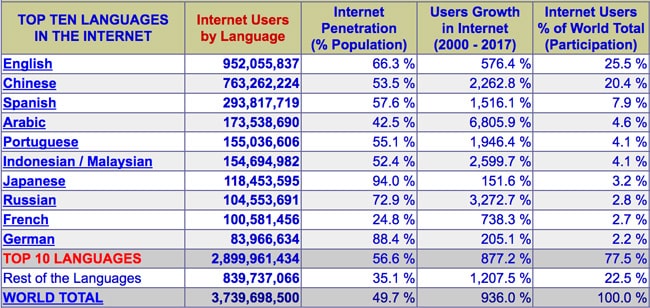The business case for translating your website
If there were only 100 people in the world, says web globalisation expert John Yunker, more than half of them would live in Asia. North America would account for only seven.
This is a bit of a jarring mental exercise but one that highlights how much population and economic growth has taken hold outside of the world’s developed markets. And it’s an idea that underpins the business case for investing more in adapting the structure, design, and content of your website for international markets.
The following table illustrates the composition of global Internet usage in terms of the native languages of users, and it offers a couple of broad observations on the state of the web today.

Internationalise then localise
In a recent interview, Mr Yunker makes an interesting distinction between the related processes of internationalising and then localising your website: “Internationalisation is the process of making your website ‘world ready,’ and localisation is the process of adapting the website to one or more locales. I like to use this automotive analogy: Toyota first had to ‘internationalise’ the car by creating a platform that supported a steering wheel on either side, different engines, etc. The localisation of that car happened when it had to adapt to each region/country of the world.” To bring that automotive example back to the web for a moment, the internationalisation phase bears more on the architecture and design of your website. This is the point where you make some important decisions that will make the site more easily adaptable to different markets or languages. There are three key ideas to hold in mind at this stage: 1. Keep it simple. Avoid heavy graphics or extensive use of rich media, especially to the extent that such elements will interfere with page performance on mobile devices. Mobile is especially key in major markets such as China and India, and plays an important role in burgeoning African markets as well. But whether mobile or desktop, a simpler site design can also adapt more readily to the spacing and styling requirements of different languages and letterforms. For example, some languages, such as Arabic or Hebrew, are read right to left. This means that basic interface elements on multi-lingual sites, including background images and calls to action, have to be designed with such fundamental variations in mind. 2. Play by the rules. As with all things web, it is always best to build and operate your website according to established web standards and best practices. And in today’s globalised context, there are plenty of guidelines in place for handling a wide range of languages. The World Wide Web Consortium (W3C) is the international standards body for the Internet, and it has published a considerable amount of best practices guidance on the subject, including a detailed index for styling text content in multiple languages. 3. Take your brand with you. In another recent post, Tim Parry points out that the strongest global brands rely on an equally agile and adaptable brand messaging. “Brands that use simplicity in their messaging typically have an easier time translating their overall brand voice,” he says. “Avoid buzzwords, which tend to be tied closely to a specific place and time, and instead focus on emotional values to make your brand more universal.”
Time to translate
Machine translation, notably from such services as Google Translate, seems to get better all the time. Even so, there is a growing body opinion that marketers should be prepared to invest in human translation, and especially so for languages used in key target markets. Aside from that, the key point to hold in mind is that localise where and when you can. “Take it slow and think long term,” adds Mr Yunker. “Remember that every globally successful website today, including Facebook, Amazon and Google, began with just one language.” When it comes to an institution or school website, the implication in this approach is that you might use human translation for only part of your site or only for languages spoken in key target markets. (Perhaps leaving yourself the option of using machine translation for lower priority content or languages.) For some further thoughts on strategy in this area, please see our earlier post on the subject, “Lost in translation: the challenge of delivering web content in many languages”.
















